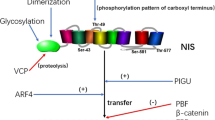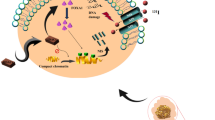Abstract
Although radioiodine has been applied in thyroid diseases including carcinoma for over 70 years, it was only in 1996 that the basic molecular mechanism of iodine uptake was identified. Iodide is actively transported into the thyroid via a membrane glycoprotein known as sodium iodide symporter (NIS). NIS mediates radioiodine uptake into thyroid normal and cancer cells. The knowledge on NIS expression has provided scientific background to the empirical management of thyroid carcinoma. Based on recent studies of the NIS gene, this paper provides current clinical applications and future studies.
Similar content being viewed by others
References
Fernandes JK, Day TA, Richardson MS, Sharma AK. Overview of the management of differentiated thyroid cancer. Curr Treat Options in Oncol. 2005;6:47–57.
Sampson E, Brierley JD, Le LW, Rotstein L, Tsang RW. Clinical management and outcome of papillary and follicular (differentiated) thyroid cancer presenting with distant metastasis at diagnosis. Cancer. 2007;110:1451–6.
Van Nostrand D. The benefits and risks of I-131 therapy in patients with well-differentiated thyroid cancer. Thyroid. 2009;19:1381–91.
Kim S, Chung JK, Min HS, Kang JH, Park DJ, Jeong JM, et al. Expression patterns of glucose transporter-1 gene and thyroid specific genes in human papillary thyroid carcinoma. Nucl Med Mol Imaging. 2014;48:91–7.
Chung JK, Cheon GJ. Radioiodine therapy in differentiated thyroid cancer: the first targeted therapy in oncology. Endocrinol Metabol. 2014;29(3):233–9.
Lee J, Nah KY, Kim RM, Oh YJ, An YS, Yoon JK, et al. Effectiveness of [(124)I]-PET/CT and [(18)F]-FDG-PET/CT for localizing recurrence in patients with differentiated thyroid carcinoma. J Korean Med Sci. 2012;27:1019–26.
Fernandez CA, Puig-Domingo M, Lomena F, Estorch M, Camacho Marti V, Bittini AL, et al. Effectiveness of retinoic acid treatment for redifferentiation of thyroid cancer in relation to recovery of radioiodine uptake. J Endocrinol Investig. 2009;32:228–33.
So YK, Son YI, Baek CH, Jeong HS, Chung MK, Ko YH. Expression of sodium-iodide symporter and TSH receptor in subclinical metastatic lymph nodes of papillary thyroid microcarcinoma. Ann Surg Oncol. 2012;19:990–5.
Chung JK, Kim MJ, Youn H. Lesionalized therapy beyond personalized therapy in cancer management. J Korean Med Sci. 2014;29(10):1331–2.
Min JJ, Chung JK, Lee Y, Jeong J, Lee D, Jang J, et al. Relationship between expression of the sodium/iodide symporter and (131) I uptake in recurrent lesions of differentiated thyroid carcinoma. Eur J Nucl Med. 2001;28:639–45.
Barbara S. Death but one unintended consequence of gene-therapy trial. CMAJ. 2001;164(11):1612.
Lee YJ, Chung JK, Kang JH, Jeong JM, Lee DS, Lee MC. Wild-type p53 enhances the cytotoxic effect of radionuclide gene therapy using sodium iodide symporter in a murine anaplastic thyroid cancer model. Eur J Nucl Med Mol Imaging. 2010;37(2):235–41.
Kim YH, Youn H, Na J, Hong KJ, Kang KW, Lee DS, et al. Codon-optimized human sodium iodide symporter (opt-hNIS) as a sensitive reporter and efficient therapeutic gene. Theranostics. 2015;5(1):86–96.
Acknowledgements
I thank all my teachers, family members, and friends who gave me endless encouragement and support for the successful completion of this project.
Author information
Authors and Affiliations
Corresponding author
Ethics declarations
Conflict of Interest
June-Key Chung, Hyun Woo Kim, Haewon Youn, and Gi Jeong Cheon declare no conflict of interest.
Ethical Approval
This article does not contain any studies with human participants or animals performed by any of the authors.
Rights and permissions
About this article
Cite this article
Chung, JK., Kim, H.W., Youn, H. et al. Sodium Iodide Symporter (NIS) in the Management of Patients with Thyroid Carcinoma. Nucl Med Mol Imaging 52, 325–326 (2018). https://doi.org/10.1007/s13139-018-0540-y
Received:
Revised:
Accepted:
Published:
Issue Date:
DOI: https://doi.org/10.1007/s13139-018-0540-y




